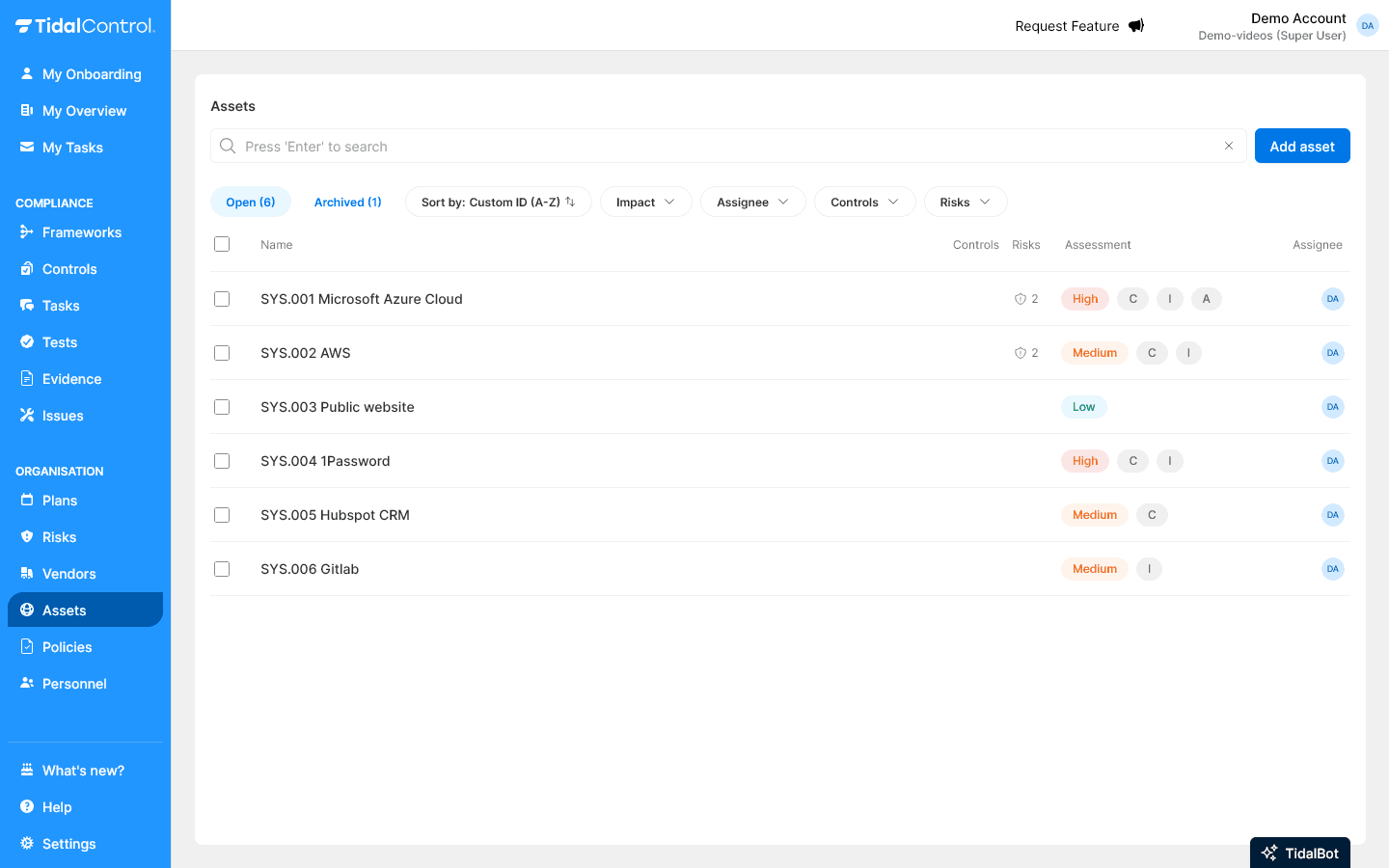Assets
Getting started with Assets
title: Getting started with Assets description: Learn what Assets are in Tidal Control and how to use the Assets page to manage your business assets sidebar_position: 1
What are Assets in Tidal Control?
Assets in Tidal Control are all business resources that are important to your organization. These can include:
- IT systems - Servers, applications, databases
- Software - SaaS solutions, internal tools, licenses
- Hardware - Laptops, network equipment, printers
- Vendors - External parties that provide services
- Locations - Offices, data centers, production facilities
By registering assets in Tidal, you gain insight into risks, compliance status, and responsibilities for each business resource.
You can link Assets to risks, controls, and tasks. This allows you to split tasks across 5 different Business Units, or assign specific controls to high-risk software.
Read more about this in Asset Management
Navigating the Assets page
Opening the Assets page
Go to the Assets section via the main menu. You'll arrive at an overview page showing all assets from your organization.

What you see in the overview
The assets overview shows:
- Asset name - The title of the business resource
- Custom ID - Your own reference number (optional)
- Number of linked controls - Which controls are relevant for this asset
- Number of linked risks - Which risks are relevant for this asset
- Owners - The person(s) responsible for this asset
- Status indicators - How risky this asset is
- C I A rating - Which quality criteria (Confidentiality, Integrity, and/or Availability) this asset scores high on
Archived Assets
At the top of the overview, you see two tabs:
- Open assets contain the current active assets
- Archived assets contain assets that are no longer in use
Archive assets when they are no longer actively used. They are kept in the archive for audit trails and historical reference, and you can always restore assets from the archive later.
Use archiving to keep your overview organized. Archived assets disappear from daily workflows but remain available for reporting and compliance.
Search and filtering
Search functionality
Using the search bar:
- Click in the search bar at the top of the overview
- Type asset names or custom IDs
- Press 'Enter' and your search results will be shown
Filter options
Use the filter dropdown menus to find specific assets:
Filter by attribute:
- Select from predefined attributes
- For example: "Critical", "Cloud", "Vendor"
- You can add attributes to Assets yourself. Read more about this in Managing Assets
Filter by risks and/or controls:
- Filter assets based on their linked risks and/or controls
The filters contain options 'no risk assigned' or 'no control assigned' that allow you to quickly identify missing links in your setup.
Filter by assigned persons:
- Filter by owners, executors, or assessors
- See directly which assets fall under your responsibility
Combining multiple filters: You can use different filters simultaneously to find very specific asset sets. For example: all critical IT assets with high risk assigned to you.
Sorting and organizing
Sort options
Click the sort dropdown to order assets:
By date:
- Old to new - Oldest assets first
- New to old - Most recent assets first
By identification:
- Custom ID (A-Z) - Alphabetical by your reference numbers
- Custom ID (Z-A) - Reverse alphabetical
- Name (A-Z) - Alphabetical by asset name
- Name (Z-A) - Reverse alphabetical by name
By impact:
- Impact level from highest to lowest - Critical assets first
- Impact level from lowest to highest - Least critical assets first
Efficient working: Combine sorting with filters for optimal workflow. For example: filter on your assigned assets and sort by impact level to quickly see priorities.
Interpreting results
Empty results:
- Check if your filters aren't too restrictive
- Look in the "Archived assets" tab
- Possibly no assets have been created yet
Too many results:
- Add additional filters to refine
- Use the search function for specific terms
- Sort by relevance (e.g., impact level)
Next steps
Now that you know how to find and filter assets, you can:
- Add assets for new business resources
- Perform assessments to map risks
- Create links with controls, plans, and risks
No assets visible? This may mean that no business resources have been registered in your Tidal environment yet. Start by adding your first asset via the "Add Asset" button.
- Previous
- Troubleshooting & FAQ